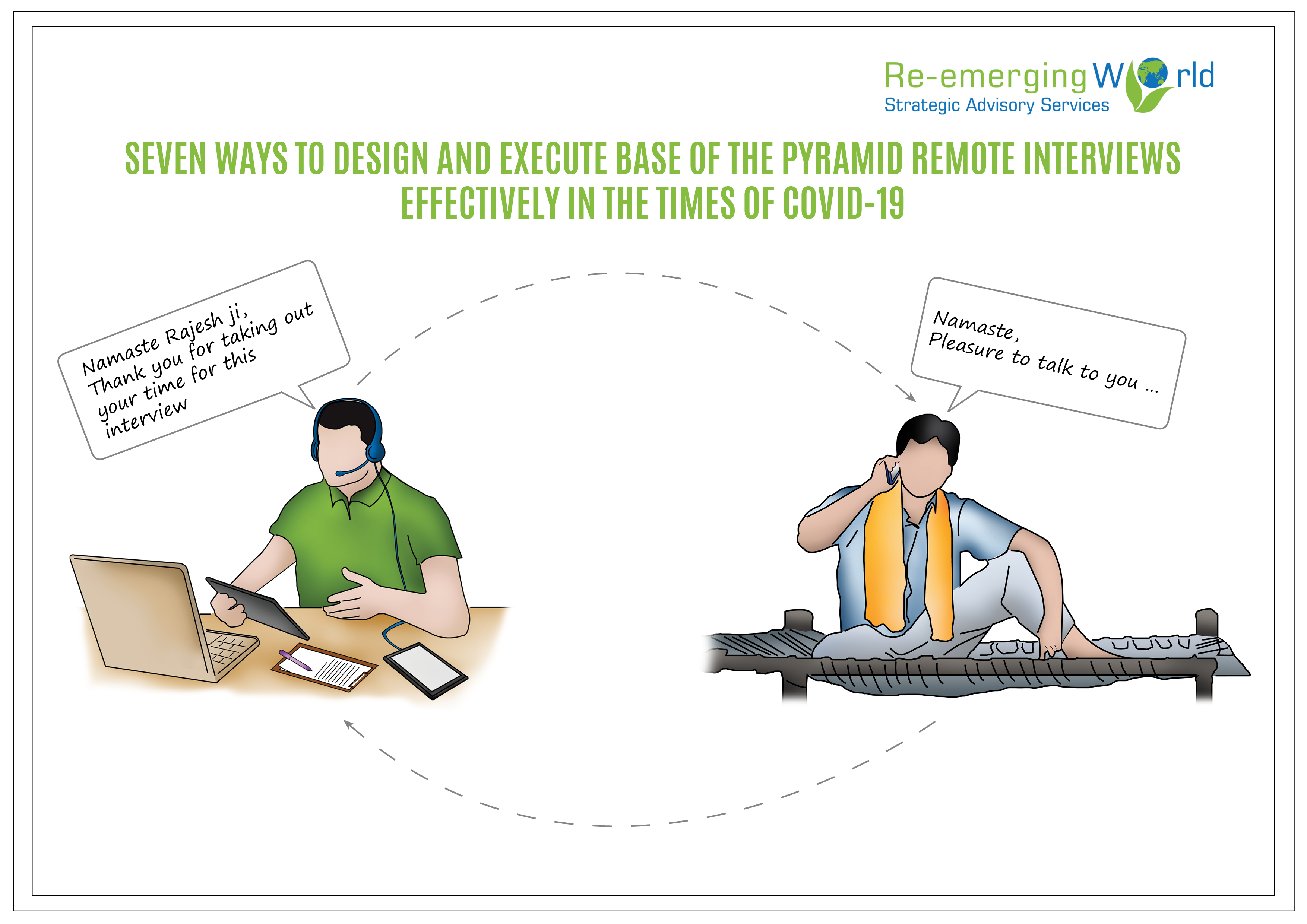Seven Ways to Design and Execute Base of the Pyramid Remote Interviews Effectively in the times of COVID-19

In the last five months, we have witnessed a gradual shift towards the “new normal” of integrating social distancing in every aspect of our personal and professional lives. Base of the Pyramid research is not an exception, and we need to calibrate our methodologies accordingly.
It is evident that the outbreak of COVID 19 will not allow researchers and enumerators to make field visits soon. But we will still need data and insights to measure, learn, and evaluate the actions, outcomes and impacts from our BoP programs. How can we do that? The answer lies in designing and executing effective remote interviews with key program stakeholders – direct or indirect beneficiaries, core value chain actors, ecosystem supporters and ecosystem influencers.
There are Seven ways in which we can make remote interviews more effective.
During the Design Stage
1.Plan the Logistics of Remote Interviews with Inputs from the Frontline Staff
Will the target beneficiaries be comfortable over a phone call or WhatsApp call? What is a good time to call mothers – morning, afternoon, or evening? Which number is used by the respondent to make and receive calls? The frontline staff, usually a local person, will be the best person to answer these questions. Take their inputs to schedule the remote interviews to kickstart the planning. You can run through the final remote interview plan with the frontline staff and seek their help in ensuring the availability of the respondents for the scheduled phone call.
2.Keep the Remote Interviews shorter than in-person ones, ideally 30 (+/- 5) minutes. If you feel the interview may go over 30 mins, break it into two sessions spread over two separate days.
It is important to keep respondents interested and engaged during interviews. However, in remote interviews, this can be particularly challenging. The typical length of a remote interview should not exceed 30 mins. However, there might be instances where the need for the research requires an hour-long discussion. The best way to administer this is by breaking it into two sessions of half an hour each. This way you get undivided attention from the respondents and can bring out the data and insights you want.
3.Design a discussion guide with simple, clear and non-ambiguous questions
Let us imagine we are interviewing a mother who missed taking her child to the vaccination booth last month that occurred in her village. This can be due to a range of internal factors like knowledge and awareness, willingness, the influence of family members or external factors like hard to reach, lack of information about the booth etc. We need to bring out the insights on the barriers.Which qualitative question will work better – “You could not take your child for vaccination last month. What were the challenges and difficulties for you?” OR “Why couldn’t you take your child for vaccination last month?”. Yes, the latter. Because it is simple, clear, and non-ambiguous.You can follow this up with a quantitative dropdown question with ten probable options from which the researcher can select one without actually asking the respondent.
During the Execution Stage
4.For a beneficiary interview, the presence of frontline staff will make the respondent comfortable. Administer the remote interview through a conference call between the researcher/enumerator, frontline staff and the respondent.
During field research, the frontline staff often help in introducing the research team with the respondents. This enables trust and makes the respondent comfortable. How can we calibrate this for remote interviews? Let the frontline staff initiate a conference call to connect you with the respondent. During your design and planning stage brief the frontline staff to introduce you. He/she can also help you in translating local language or dialect if the need arises.
5.Prepare an introduction which can build trust
A good introduction is always helpful, more so for remote interviews where you need to build trust quickly. Start with a quick note of thanks for taking out time for the phone call. Be honest and clear about the objectives of the interview. Make the respondent feel important – express how important his/her views and opinions will be for the program. Take this opportunity to ask for permission if you are audio recording the interview. A crisp, positive introduction helps to start the interview on a pleasant note both for the interviewer and the respondent.
6.Paraphrase and cross verify; you can compensate for the missing non-verbal cues
Non-verbal cues from respondents like nodding, shrugging off the shoulders, and eye movements are boon for field researchers. However, be prepared to miss them in remote interviews. Instead, build paraphrasing and cross verifying in the way of administering the interview. This will become a quality check for the insights captures and will improve its accuracy.
7.Minimize the risks of data loss by using multiple modes and devices to capture data; be efficient by pre-filling some sections
Audio record phone call interviews by taking due permission from the respondent. This will help you trace back any insights or data you have missed writing down in the response sheets. For qualitative data, you can use the hard copy of the questionnaire to write them down or type them directly on a templatized database. If you are using a mobile application or excel sheet to capture quantitative data, save some time by creating drop-down options wherever applicable. Pre-fill some sections like general details of the respondents and verify them during the interview to be efficient.










